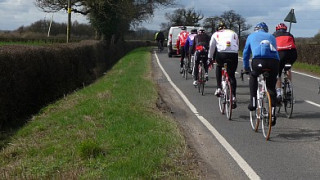British Cycling submitted a consultation response to the Department for Transport’s proposals to increase lorry speeds for those over 7.5 tonnes from 40mph to 45 or 50mph on single carriageways.
British Cycling believes that an increase in speed for the heaviest lorries poses a significant road safety risk to cyclists in particular, and to all road users.
“When the consultation was first announced we pointed out that this was an example of the government not considering cycling before proposing policy changes. If the Department for Transport is serious about getting more people on bikes it must make sure that all new roads policies are consistent with that objective.”
Martin Gibbs, Policy and Legal Affairs Director, British Cycling
In our response we have called on the government to keep the speed limits as they currently are as we believe that the 40mph limit was established for sound safety reasons which remain valid today. In fact, there are factors which make the maintenance and enforcement of the current limit even more important than when the limit was implemented. On a single carriageway it can be difficult for an HGV to pull round someone on a bike, particularly if there is oncoming traffic. HGVs have got wider and longer since the current limits were introduced and traffic density is higher. The potential increased danger posed to cyclists should have been clearly and specifically addressed before this consultation was launched.
Policy and Legal Affairs Director, Martin Gibbs said “When the consultation was first announced we pointed out that this was an example of the government not considering cycling before proposing policy changes. If the Department for Transport is serious about getting more people on bikes it must make sure that all new roads policies are consistent with that objective.”
British Cycling believes that it is highly likely that an increase in the HGV speed limit would pose greater risks and deter people from cycling. Lorries are responsible for 19% of fatalities involving people cycling, despite making up 5.1% of road traffic.
We know that restrictions on HGV movements can have real safety benefits. For example, in Paris, where the biggest lorries are banned except with special authorisation and only smaller lorries can make daytime deliveries, there were 2 cycling deaths in 2010 and none in 2011. By comparison, in London ten people were killed when cycling in 2010, four of which were caused by HGVs and in 2011 16 people died when cycling, 9 of which were caused by HGVs.
These figures prompted Transport for London to commission research into ‘Construction logistics and cyclist safety’. The findings from the research, which has just been published, found a lack of awareness and ownership in the construction industry, vehicle designs, as well as industry practices and standards were contributing to the problem.
We know that speed has a significant effect on casualties. In 2004, a Norwegian study found that 10% decrease in speed corresponded with approximately 37% decrease in casualties [1], and conversely, when Australia increased their speed limits by 10kph they saw an increase in fatalities by 25% [2]. Closer to home, the Department for Transport’s own commissioned research by TRL in 2011 found that of all the possible measures, reducing speeds would have the biggest impact on reducing cycling casualties[3].
Read our full response to the consultation here.
[1] Elvik, R et al (2004) Speed and road accidents: an evaluation of the Power Model
[2] http://pedestrianliberation.org/2011/03/02/costs-and-benefits-of-80-mph-speed-limits/
[3] TRL study 580; November 2011; Infrastructure and cyclist safety;













